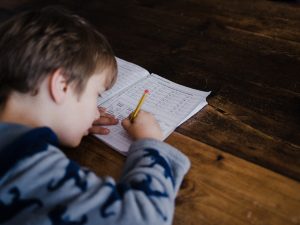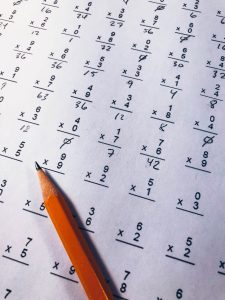Wow! Did I really just say that? Flashcards WILL fail your child – unless they have a photographic memory – when it comes to initially learning times tables. Imagine for a moment that the flashcards were for learning a foreign language and YOU were the student. Do you think you would be able to learn the phrases and know about the grammar in the sentences just by having a flashcard shown to you over and over again? Or do you think it might be more effective to LEARN about the words in the phrase, how the tense affects the grammar and THEN look at the sentence as a whole? Exactly.

This is how it should be for learning times tables too. Unfortunately, we have grown to accept that by showing a flashcard to a child often enough, the fact will somehow be cemented in their memory. And not just one flashcard – dozens of them at a time. It is no wonder so many children struggle with times tables facts.
But don’t worry. There is another way to help them master the multiplication tables. A BETTER way.
When I was a child, we had to learn our multiplication tables by rote, standing up and chanting them as a class. Now, this method can be effective, but it does not teach any rules associated with the multiplication facts, and it involves remembering A LOT of words. That is, in effect, what we do when we chant tables. We are learning words, pretty much like we would do when we learn the words to a song. Sometimes we hit the jackpot and we can remember every single word to the song but, more often than not, we probably remember most of the words and mumble over a few or mix up the verses.
Learning times tables by rote can be difficult.

That’s where REAL learning comes in. When we learn about times tables, we learn about the patterns each table makes. A good starting point is to use a hundred square to count up in whatever number you want your child to focus on. I like to use a digital 100 square as it is more environmentally friendly. I like Top Marks’ Paint the Squares. You can find it here: https://www.topmarks.co.uk/learning-to-count/paint-the-squares
Using the splat function makes a ‘splat’ noise, which children seem to love! Get your child to splat all the numbers counting in 2s, for example. Then ask them what they notice about the numbers they have splatted. What can they tell you? They should be able to point out that there is a repeating pattern in the units place – 0, 2, 4, 6, 8, 0, 2, 4…. – and that these numbers are all even numbers. By making them aware of these facts, you are laying the foundations for more complex understanding later on, for example, by knowing if the units digit is even, the number must be divisible by 2.
This type of task is easy to do with any of the multiplication tables. Using an interactive resource like Top Mark’s Paint the Squares makes it fun, but it is also great to practice this with a printed 100 square and counters. Taking it one step further – as I live by the beach – wouldn’t it be fun to make a HUGE 100 square in the sand and jump along the numbers, making it a totally physical and multisensory activity?!
When your child becomes familiar with the rules and the patterns of a multiplication table, the next thing to do is to use those flashcards. This is the point where they are useful. Not to learn the tables but to PRACTICE and REVISE the facts. I like to use both physical flashcards and interactive digital resources.
There are plenty of ways to practice the times table facts WITHOUT using flashcards. Here is how to play ‘Heads Up’ with a simple deck of cards. If we keep with the two times table, you can put a ‘2’ card on the table. Spilt the rest of the pack between you and your child (removing all the picture cards). Your child takes the card at the top of their pile and holds it to their head. Let’s imagine it is a 7. You would say “2 times something is 14” and your child would work out the answer is 7. You would take turns in this game. Isn’t this more fun than rushing through a pile of flashcards? 😊

Another fun way to practice the tables facts once you have gone over the rules and the patterns is to roll a dice. You can buy dice with 10-12 sides to make this activity cover the whole range of multiplication facts. Initially sticking with the times table you are focusing on, roll the dice and ask your child to tell you the fact associated with the number and the answer. For example, if we stick with the 2 times table and roll a 9, your child says “2 times 9 is 18” and so on. Once they have learned all the times tables, you can use two dice to give you different combinations, covering different multiplication facts.
Mixing it up a little more, you can use a deck of playing cards and a dice. Turn over a card and roll the dice. Multiply the two numbers together.
I have made a version of the popular ‘Connect 4’ game in a gameboard style. It has a grid with the multiples (the answers) of different times tables facts to “six times six”, making it easy to use with regular dice. If you would like to download this and use it at home with your child, CLICK HERE.
This allows you to join my list, where you will be the first to know about any freebie games I have made and any courses and classes I have to offer. Go on. Download it now and put those flashcards away.
These ideas are definitely much more fun than turning over a bunch of flashcards!
Want to be one of the first to sign up for my BRAND NEW ‘Master Your Multiplication Tables in a Month’ course? CLICK HERE to find out more!

